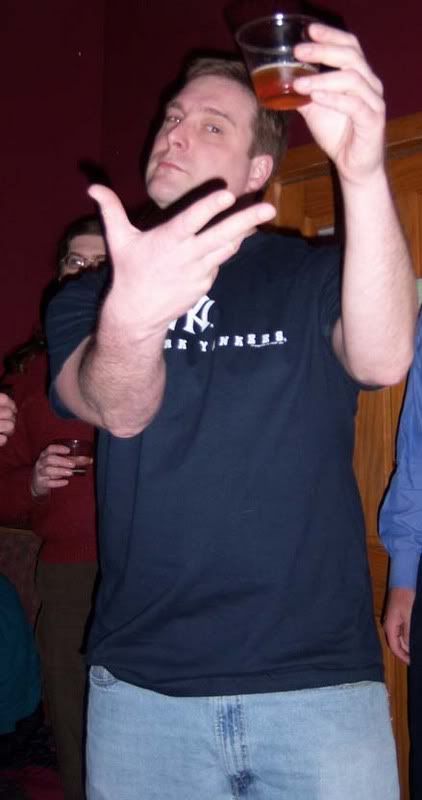Monday, July 23, 2007
Saturday, July 21, 2007
The Beercraft Blog, now with increased functionality!
The new site has search functionality, which is nice with a 300+ post blog.
I'm still getting used to the new system, and the look will be updated shortly. Right now, it just uses a generic theme. But hell, you don't come here for pretty layout, you come here to read about beer!
Anyway, I'll be posting on both sites for a while, just until the kinks are worked out. Now, if you'll excuse me, I have to catch a bus to Cooperstown.
-Mark
Friday, July 20, 2007
Beer in Europe- the travels of Mark, Part II
There are lots of picturesque, stately towns in Germany, and Cologne is not one of them. You'd think any town with the worlds largest gothic cathedral would try to measure up with the rest of its buildings. This is not the case. The Dom (cathedral) is settled on top of a huge concrete slab, across the skateboarder-infested square from the train station. All the surrounding buildings on the south side are squat corporate lego-offices built in the '60s. North of the church runs the Hohestrasse, a cloned German pedestrian shopping street in which high-end boutiques mingle with kebab stands and lowbrow discount stores. On the Hohestrasse, you could be in any crowded city in Germany.

The Cathedral and an inexplicable David

The Altstadt and the Rhein seen from the Cathedral
That's ok, though. We weren't there for shopping or architectural wonder. We were there for the Kolsch.
Light in body, light in alcohol, and unique to Cologne, Kolsch is at once a unique beer style and a proud symbol of a city. "We served our Kolsch in .3 liter glasses," the bartender in an Irish pub told us, "and the locals got mad because they were too big."
You see, traditionally, Kolsch is served in .2 liter glasses (6.7 fluid ounces). When you finish one, the server doesn't even ask; he or she simply fills another one and marks it on your coaster. You have to tell them to stop. Because the beers are so small, it takes an army of servers, all running around with their special Kolsch-carrier trays, to keep up with demand.

This beer gave me a complex
On the positive side, with such small, regular doses, it's certainly easier to control your buzz, which is something I had absolutely no interest in doing.
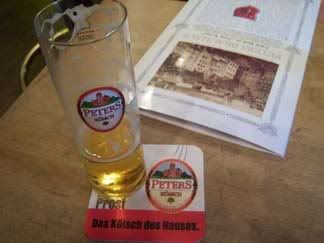
My second Peters Kolsch of the evening
Kolsch is only brewed in Cologne, and several principal brewers vie for market share. Gaffel Kolsch is the biggest, and probably the only brand you'll find in the USA. There's also Sion, which is better, Frueh, which is better still, and Peters, which tastes the best. Each of these breweries has a beer hall on premises, where you can eat traditional meat-oriented German food to buffer yourself from the onslaught of beer shots.
Lumps of meat aside, I still woke up with a hangover.
Next post: Belgium Comes to Cooperstown
Monday, July 16, 2007
Beercraft newspaper article #43: Trappist ales
In Belgium, the quest for the Holy Ale continues
This column is being written literally hours before the start of a trip to Belgium. That’s right, gentle reader. We at Beercraft are so focused on bringing you accurate, up-to-date information on the world’s beers that we’re willing to travel across an ocean to find it. And we swear we’re not just using this column in an effort to write off a vacation in Europe.
Anyway, since the plane is leaving in three hours, let’s get down to today’s topic: Trappist Ale. And no, it’s not made by dudes in buckskin and fur hats with raccoon tails.
The Trappists are a monastic Catholic order that follow the teachings of Saint (not Pope) Benedict. They’re technically called “The Order of Cistercians of the Strict Observance, but that’s awfully wordy for a beer bottle. Instead they take their moniker from the abbey of La Trappe. Most of their abbeys are located in Belgium, although the order has spread to other regions as well.
These guys are serious monks. They live a life of rigorous personal poverty. They remain silent as much as possible during the day. They basically do two things: work and pray. When not at prayer, they’re making products to support the abbey: Cheese, bread, even clothing. But the most famous fruit of their labor is the Trappist ale that has given Belgium international renown as the world’s beer Mecca.
Belgian law allows only six abbeys to sell their beer as Trappist ale: Achel, Orval, Chimay, Rochefort, Westmalle, Westvleteren and Koenigshoeven. There are numerous other “abbey ales” that are brewed by laic interests and not necessarily at the monasteries themselves.
For many, the beers produced by these six represent the holy grail of brewing. They are all exquisite, Brown or reddish in color, with a fruit and nut aroma and complex malt flavor. Each sip reveals more intricacy of flavor: a hint of coriander, caramel, is that… citrus? Trappist ales are more deep and complex than any other beers in the world.
Trappist and Abbey ales are categorically divided by strength. There’s Singel, which is already strong, Dubbel, Tripel and Quadrupel, which can tip the scales at a skull-crushing 12%. Hey, even a monk gets to live a little!
Unfortunately, Trappist ale seems nigh-impossible for brewers outside of Belgium to duplicate. Each abbey uses a proprietary strain of Belgian yeast, and they’re not giving it out to just anybody. Brewery Ommegang in Cooperstown New York comes the closest, benefiting from the resources of its Belgian parent company Duvel, a longtime brewer of abbey ales.
Other American stabs at the Trappist/Abbey style have yielded good, if inauthentic, results. If your only exposure to “Belgian Ale” has been through a bottle out of the Saranac Summer Sampler 12 pack, it behooves you to try a glass of the Trappist stuff. It’s night and day (although we’ll happily down a few of the Saranacs too).
As you might expect for a beer style brewed by monks in only six abbeys in a tiny European nation, Trappist ale is not cheap. In a Rochester beer bar, expect to pay wine prices. But that’s the cost of greatness. If it’s cheaper in Belgium, we’ll let you know.
Although it seems doubtful that Delta will give us any on the flight over.
In other beers:
Old Toad General Manager Jules Suplicki has recently taken on the responsibility of beer selection for the bar, and she’s developing nicely. Using patron recommendations as well as those of beer distributors, Suplicki has built an eclectic lineup of excellent beers.
Last Sunday the Toad was featuring Okocim Porter on draft and Czechvar (the real Budweiser) as a bottle special. You just don’t find these beers in Rochester bars. Well done, Jules!
Suplicki’s predecessor in the Toad’s Cellar, Joe McBane, is hard at work hand-renovating his new beer bar, in the old Gregory Street MacGregor’s location. We recently had a look at the construction. He’s gutted the place. Don’t expect MacGregor’s when the new bar opens in August. Do, however, expect a fantastic beer selection!
Bruce is a certified beer judge and commercial brewer. Mark owns a laptop and likes beer. For more on beer, check out the beercraft blog, updated regularly, at http://beercraft.blogspot.com. Send your questions, suggestions, or comments to beercraft@rochester.rr.com.
Wednesday, July 11, 2007
A beer too far- Mark's trip to Europe
Such were the circumstances under which I found myself, debarking the 767, wearily trudging through the absurdly lengthy concourse of Brussels Airport, only to glimpse my first Leffe taps while still in the Arrivals hall.
This vacation was going to be trouble.
I am, however, a model of restraint and self-control. We dragged our jet-laggy asses into our hotel on the Boulevard Adolphe Max, in the heart of the busiest part of town, and had a nap before venturing out to experience cafe life in Belgium's first city.
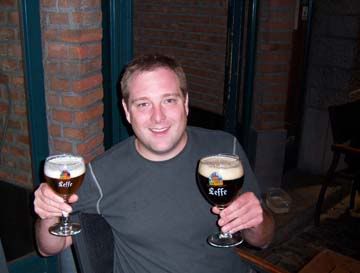
A blonde on one arm, a brunette on the other
Leffe Brown. Leffe Blonde. Orval. Duvel. Rodenbach. Westmalle. Achel. Some I've never tried. Some I can get here in Rochester, but nowhere near as fresh. It was like a candy store. Except the candy was Trappist and abbey ale. The beers that American beer lovers would savor and cellar here in the USA consumed as casually as Miller Genuine Draft by the Belgians.

Christian Qvist, of Denmark, enjoys a Ramee
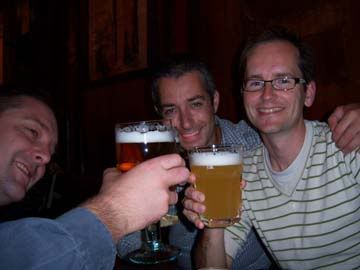
More drinking with the Danes
Of course, the setting provides a great deal of the enjoyment. Sipping a Kasteel Brown at a cafe on the Grand Place, or a refreshing Jupiler in the Place du Sablon, or being taught a lesson by a crusty old bar owner about Boons Kriek (the best fruit lambic in the world) in his backwater Flemish tavern- it definitely adds a new dimension to beer usually enjoyed only abstractly, without context.
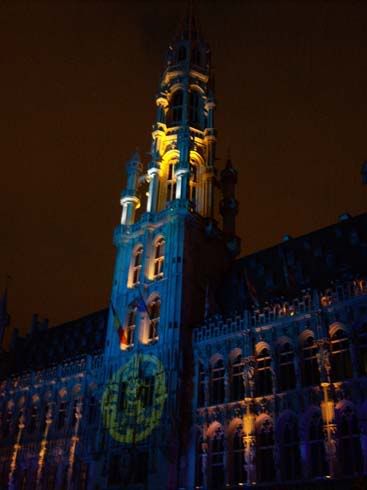
the Hotel de Ville at night, viewed from the touristy Roi d'Espagne bar in the Grand Place

A beer-drinking backdrop in the Place du Grand Sablon
Sure, the hangovers were mighty and plentiful, but such is the life of a beer lover.
We stayed in Belgium for four days before hopping on a train heading randomly west, only to find ourselves in another fantastic beer town sipping from 0.2 liter glasses in the shadow of the largest gothic structure in the world. That's a story for another post...
Beer School this week
Since I have lambics on my mind, that's what we're hitting this Thursday, 7:30pm, at Monty's Korner. The famous fruit beers of Belgium await your eager palates!
Tuesday, July 10, 2007
Back from Belgium and Germany
-Mark
Tuesday, June 26, 2007
Beer fest and Beer school
While you're sampling some of the finest beers anywhere, you can rest assured that I'm conducting exhaustive research on Belgian brew in order to properly advise you, the consumer. Pics will be posted.
Oh, and look for the Victory Brew Fest at Monty's Krown on Saturday, June 30. Victory Brewing Company rep Steve German will be on hand with an array of cask, draft, and bottled things for you to try. Unfortunately, I will miss it, because I will be drinking trappist ales at the source.
-Mark
Monday, June 25, 2007
A work in progress
The old MacGregor's on Gregory Street is well along in its renovation, but there's still plenty of work to do. When this place opens, it is not going to be a warmed-over MacGregor's; the building is getting a complete refurb from the basement to the roof.

The as-yet-unnamed bar still looks forlorn

Come have a fine beer in their inviting atmosphere
"Hey Mark," you say. "How can this be the best beer bar in Rochester before the place is even built?" I just ask you to trust me. Joe McBane, former cellar manager at The Old Toad, is a wizard at finding excellent, unexpected beers from all over the world. He has poured me too many rare and pleasant surprises to count, and the man knows how to keep his beer fresh and at the proper temperatures.
Oh, and he's English, so that has to give him SOME beer cred, right?
Thursday, June 21, 2007
Beercraft newspaper column #42: Fruit beers
The best thing about getting into craft beer is the sheer variety of tastes that opens up to you. But let’s face it, sometimes beer alone just isn’t enough. Sometimes you need some fruit in that beer.
Fruit has been used as a flavor agent in beer for hundreds of years, and, thanks to our Belgian friends and the ingenuity of American brewers, fruit beers are enjoying something of a mini-renaissance.
It sounds strange, but beer didn’t always taste as delicious as it does today. A lack of chemical knowledge made it harder for brewers to control the brewing process; yeast wasn’t even understood until the 1800s. In Belgium, the spontaneously fermented beers came out champagne like in texture and quite sour. To make it more palatable, the Belgians came up with a practical solution: add fruit.
Thus the cherries and raspberries of Flanders’ fields became the hallmark ingredients in Lambic, the classic Belgian fruit beer. These have since been joined by currants, peaches, apples and whatever else the marketers in Antwerp could think up to diversify the product range. The Kriek (cherry) and Framboise (raspberry) are the acknowledged classics, however. Depending on the brewery, they can range from astringent and dry to very sweet and fruity.
You can find plenty of different lambic in various flavors at Beers of the World, but if you’re looking for lambic on draft, it’ll be tough to get anything but Lindemann’s Framboise- a light, tart champagney beer that clubs you over the head with raspberry. It’s very pretty in the glass, a deep red hue with pink foam (you probably shouldn’t sip these before climbing on your Harley). Raspberry essence swirls into your nose ever time you raise the beer to your lips, creating, uh, “the ultimate raspberry experience.”
If you want an edge in impressing your date, order her up a Framboise and watch the delight spread across her face. Unless she’s allergic to raspberries. No one is delighted in the emergency room.
Lambics are by no means the only beer style flavored with fruit. Most others, however, have been lost to the ages. But American craft brewers, have spurred something of a resurgence in fruit beers, and most of the big players on the craft beer scene have one in their product lineup.
For example, there’s Magic Hat #9, from the Magic Hat Brewing Company of Burlington, Vermont. Like all beer from Vermont, the Magic Hat is swathed in hippie ethos and trippy packaging, but the contents of the bottle are enjoyable even without hallucinogens.
#9’s soft golden color offers the first hint of the apricot that suffuses the beer’s aroma and flavor, and the crisp bite of fresh apricots is prevalent in each swallow.
Fortunately, what you’ll get in #9 is mostly the essence of the fruit, and not an overwhelming apricot flavor. Underneath is a light-bodied, decently balanced brew. You’ll taste the sweet malt, and each sip will finish crisp and hoppy, with just a bit of bitterness.
If you’re at the Wings game, or out at their brewery in Ogden, you can have a glass of Rohrbach BlueBeary ale fresh from the tap. A longtime staple of Rohrbach’s line of beers, the BlueBeary is another example of the value of restraint. The essence of blueberry is captured without the beer turning into something you’d pour on your pancakes.
Because we like our interviews easy, we spoke with Bruce Lish, brewer at Rohrbach and co-author of this column. “BlueBeary is a great crossover beer,” Lish says. “A lot of people who don’t really like beer enjoy it.”
Lish also points out the popularity of the “Black and Blue,” a half-and-half of BlueBeary and stout. The two flavors complement each other very well and the parfait-like layering of the dark stout on top of the golden BlueBeary has enormous visual appeal.
There are plenty of other fruit beers out there; you’re certain to find others you enjoy. Fortunately, most look just like regular beer, so the guys can enjoy a pint with their machismo intact.
That’s important, even in Vermont.
Bruce is a certified beer judge and commercial brewer. Mark owns a laptop and likes beer. For more on beer, check out the beercraft blog, updated regularly, at http://beercraft.blogspot.com. Send your questions, suggestions, or comments to beercraft@rochester.rr.com.
Wednesday, June 20, 2007
Boston again
At least I had a lot of it.
I'm going to Belgium next Thursday, and there's a definite beery slant to the trip. Stay tuned, good readers, as Mark frolics among the Trappists.
Friday, June 15, 2007
It "fell off a truck."
Fortunately, it was Corona and not something good.
Thursday, June 14, 2007
Someone pass me an ice cold, imported J.W. Dundee's.
You see, J.W. Dundee's is brewed at the High Falls Brewing Company, about six blocks from the stadium where the USL Division 1 soccer team plays its home games.
Granted, the concession company the Rhinos use, Delaware North, is the shittiest, most backward in the industry. Their employees show up untrained (it'll take you 25 minutes to get a chicken sandwich out of them), their supervisors clueless. But surely a large enough number of annoyed fans have brought their attention to the fact that DUNDEE'S IS A FRIGGIN' ROCHESTER BEER for them to do something other than arrogantly say 'Well we classify it as an import.'
By the way, these geographically challenged idiots classify Labatt Blue as a 'domestic.'
My advice, drink before and after the game. Leave the concession company to rot in its own inventory. At least then it won't taste like the cheap plastic cup in which it's poured.
-Mark
Wednesday, June 13, 2007
Beer school and barley wine
We're doing Beer School tomorrow night at 7pm, at Monty's Korner. The subject: Beers of the Great Lakes. Some of the finest craft beers on the continent come from their shores, and, dammit, we're gonna taste 'em. Patrick is out of town, but hopefully Bruce will be there.
We tried theBlue Point No Apologies Imperial IPA on cask last night at The Old Toad. Absolutely fantastic. The cask conditioning lent a rich smoothness and really accentuated the hop aroma. What surprised me whas the subtlety of the beer's finish, which completely lacked the sharp hop bite usually found in barley wines. Still, the alcoholic flavor was nicely balanced in the beer. You may not find it on cask, but give it a try if you're looking for something strong.
-Mark
Thursday, June 07, 2007
A makeover for Genesee!
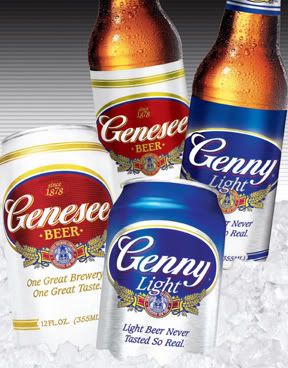
Compare to the previous "el-cheapo" packaging:

What I like best is that it shows commitment to the brand that built the brewery. Hey, I'm proud to be a Rochesterian, and Genesee is part of our heritage- the last vestige of what was once one of the greatest brewng towns in the USA. Thanks to the guys at the Genesee Brewery for not forgetting that.
Anyway, here's the full press release:
FOR IMMEDIATE RELEASE
Extreme Makeover for Genesee Beer and Genny Light
A Package Redesign and New Website for Legendary Heritage Brands
June 7, 2007, Rochester, NY – The famous Genesee Beer and Genny Light brands have just received a packaging makeover which is prominently featured on a new website exclusively dedicated to the legendary Genesee Brewing brand name. “This is all part of our renewed focus on reinvigorating our core brands.” said President and CEO Norm Snyder. “The Genesee name has a proud heritage that dates back to the late 1800’s and is a cornerstone of our regional cultural heritage.”
The new designs pay tribute to Genesee’s proud past but with a contemporary treatment that will appeal to both existing core consumers as well as new consumers of competitive brands. The initiative started with establishing an identity for the Genesee Brewing Company – an entity that High Falls Brewing Company owns but has not actively marketed since the company was founded in 2000. Elements of Genesee’s familiar “red-eye” logo from the 1960’s and 1970’s are the foundation of the parent identity as well as the flagship Genesee Beer brand. A script type face for “Genesee” lends a classic look and feel to the brand that has been in existence since 1878 when the brewery first opened on the east bank of the Genesee River. Snyder added “The Genesee brand name has tremendous equity that resonates with consumers and distributors throughout the country. Our Brewery has been producing beer under the same name at the same location since the end of the 19th century and we’re very proud of that fact.”
Lower calorie sibling Genny Light is brought back into the Genesee family with the oval logo treatment and script typeface. “We had two primary goals for this initiative.” said Gregg Stacy, Vice President of Brand Marketing. “The first was to create a cohesive brand family look for our Genesee products. The Genesee Brewing Company identity provides a parental brand foundation that ties all of the Genesee brands together. We successfully repackaged Genesee Cream Ale in 2005 and it was time to bring Beer and Light in line with the classic heritage look that has helped Cream Ale sales rebound.” Such alignment strengthens brand recognition and communicates positive brand positioning in the trade and at retail. In addition, the visual alignment with Genesee Cream Ale creates more cohesion for displays and merchandising at retail. Stacy continues, “Our second goal was to capture the true personality of the Genesee brand name. Genesee Beer and Genny Light hold very unique positions in that they are some of the last true regional brands brewed in the United States. Genesee Beer in particular has been brewed at the same location since 1878. It was very important to us that the redesign capture the true essence of these brands.” The Mirus Group of Pittsford, New York designed and produced the identity as well as new primary and secondary packaging, point of sale materials, advertising and trade sell-in support.
Hometown Favorite Gets a Homepage
In addition to core point of sale support materials and targeted out of home advertising, for the first time, the revamped Genesee brands have their own dedicated website – www.geneseebrewing.com. “The new Genesee site is a lot of fun and is sure to be a hit with Genesee history buffs and brewerania collectors” said Stacy. “We built in a museum page with shots of old ads, collectible items and a streaming video section with television and radio spots from the past. An on-line Company Store will sell a variety of “Gennywear” including hats and shirts. LogicalSolutions.net of Rochester, New York designed, produced and hosts the web site.
###
High Falls Brewing Company is located in Rochester, New York and is one of the state's oldest continually operating breweries. The company brews it’s family of JW Dundee's Lagers & Ales including Honey Brown Lager, Pale Ale, Amber Lager, Pale Bock, Hefeweizen, IPA, Porter and Festive Ale as well as its famous Genesee Brewing Company line including, Genesee Beer and Genny Light and Genesee Cream Ale. High Falls also markets imports Steinlager from New Zealand, Toohey’s New from Australia and Imperial from Costa Rica.
Tuesday, June 05, 2007
Beercraft newspaper column #41- Beers of the Finger Lakes
By Mark Tichenor and Bruce Lish
Wine tasting in the Finger Lakes is a time-honored activity. Every weekend, hundreds of area residents tour the rolling hills, going from winery to winery, swishing, sniffing, (sometimes gulping) frowning at color, comapring “legs,” reciting lines from the movie Sideways, and growing less sophisticated wth each progressive tasting room.
That’s fine. We do it too. But there’s more to the Finger Lakes than just wine; there is also beer. Just to mix things up a bit, why not add a stop at one of the region’s breweries on your next wine tour?
You can start reasonably close to home. Custom Brewcrafters’ taphouse, at 93 Paper Mill Street in Honeoye Falls, features a tasting room. They’ll also give you a free tour of the brewery on Saturday and Sunday afternoons.
It would be a shame to leave without a growler of their best beer: CB’s Double Dark Cream Porter. It’s opaque and full bodied, with lots of malt sweetness and hints of mocha and toffee. While rich and hearty, the Double Dark is still accessible enough for novice palates.
Hopping back in the limo bus (you’re not freakin’ driving are you?), it’s time to trek to Lodi, on the eastern shore of Cayuga Lake, home of the Wagner Brewing Company, 9322 Route 414. Although possibly overshadowed by Wagner’s vinyards and winemaking operation, their brwewery consistently pumps out award-winning beers.
Wagner’s India Pale Ale, Sled Dog Doppelbock, and Dockside Amber Lager are staple beers of the region, which can be purchased in bottles directly from the brewery or in beer stores. In addition, you’ll always find an interesting seasonal or two.
The Sled Dog Doppelbock is of particular interest. It’s a sweet, heavy, high-strength lager, with very little hop character. Expect a full-bodied, bready mouthfeel, and a hint of raisin in the flavor profile. It’s 8.5% alcohol by volume, so you might want to bring a Mormon to drive you home.
The Brewery hosts a pub night every Friday evening on the brewdeck. It’s food, beer and live music in an outdoor setting that’s chock full of, uh, scenicness. Wagner Brewing’s full lineup of beers and Pub Night schedule can be found at www.wagnerbrewing.com.
Since you’re already close by, head on down Cayuga Lake to the Ithaca Brewing Company, at 606 Elmira Road in Ithaca. The brewery opened in 1998 and has grown rapidly over the course of the last decade. Their bottled beers are available in four states and beers by Ithaca Brewing feature regularly on local taps.
Of note is the CascaZilla, the name of which is a descriptive pun playing on the proximity of the Cascadilla creek and the prominence of powerful cascade hops in the brew. Pouring a rich copper color, Cascazilla is one of the most palatable of the currently trendy “extreme” hoppy beers. The aroma and flavor are all hops, but brewmaster Jeff O’Neil’s recipe pulls the hop punch at the last moment with a malt balance. It’s refreshing, complex and tantalizing, and showcases what can be done with American-grown hops.
Of course, Ithaca Brewing offers a wide range of beers. They’ll educate you while you taste, fill your growler, and try to sell you a T-shirt. Find them online at www.ithacabeer.com/
There may always be a sociological gap between highbrow wine and plebian beer, but when you incorporate a couple microbreweries into your wine tour, you become a more well-rounded connoisseur of fine beverage. After all, if happiness is a cellar full of good Finger Lakes wine, than a fridge stocked with Finger Lakes beer must be ecstasy.
At the very least, it can lead to a temporary euphoria. Cheers!
Bruce is a certified beer judge and former commercial brewer. Mark owns a laptop and likes beer. For more on beer, check out the beercraft blog, updated regularly, at http://beercraft.blogspot.com. Send your questions, suggestions, or comments to beercraft@rochester.rr.com.
Wednesday, May 30, 2007
Beer- as good as the person who serves it?
Tonight I'll raise a toast to the men and women of the service industry for making my life a bit more pleasant, and my horizons a little broader. Cheers, folks. I salute you.
Tuesday, May 29, 2007
The Pacific Northwest beckons
Come out to Monty's Korner in Rochester, Thursday night at 7pm to taste the best of the Northwest. For free.
-Mark
Tuesday, May 22, 2007
Beercraft newspaper column #40- Lawnmower beers
“Lawnmower Beers” make yard work bearable.
By Mark Tichenor and Bruce Lish
Nothing beats a cold beer on a hot, muggy day, although some beers are more refreshing than others. You wouldn’t necessarily want to chase away the summer perspiration with a big, syrupy doppelbock or black Irish stout.
No, you want a lawnmower beer: a brew that both quenches your thirst and perks up your taste buds, without a thick, cloying body; a beverage to reach for after the arduous task of mowing the lawn on a scorching afternoon.
Of course, if you’re like Bruce, you have a riding mower, and if you’re like Mark, you don’t have a lawn at all, but the principle’s the same. Please allow the two of us, for whom yard work is easy, to suggest some restorative summer beverages.
Brooklyn Lager, from the Brooklyn Brewing Company, is a great place to start. Its rich copper color immediately sets it apart from the typical American lager. You can’t help but notice the flowery hop notes and aromatic, almost citrus, spiciness as the scent wafts from the glass; a promise of the flavor to come.
The first cold mouthful is a procession of sweet-tinged malt flavor, perhaps a little toasty, immediately complemented by a full, deliciously bitter flood of hop character. As you swallow, the hop tinge lingers, coaxing you into another sip. All the while, the medium body of Brooklyn Lager lends the beer a substantial quality not often present in the most mainstream American Lagers.
A quick style swap and we find ourselves holding a Sierra Nevada Pale Ale. This is one of those “gateway beers” that starts people’s appreciation of craft brewing, but its high quality and classic flavor make it a beer you never grow out of.
It’s also damn refreshing. Unlike the Brooklyn lager, Sierra Nevada’s Pale leads with its hop flavors, which then mellow into satisfying, slightly biscuit-like, full-bodied malt sweetness. The flavor is never too malt-heavy, so it avoids unnecessary sweetness or heaviness of body. Likewise, it isn’t hopped to the point where it becomes an IPA, by American standards, anyway; like most West Coast ales, you’ll still find Sierra Nevada Pale Ale hoppier than many English IPAs.
Our third choice is Prima Pils, from the Victory Brewing Company of Downingtown, Pennsylvania. Now Pilsner (the real stuff, not the buzzword you see on television beer ads) is a style not many American breweries get right, but Victory pretty much nails it.
In terms of body, Victory Prima Pils is lighter than the other two lawnmower beers we’ve discussed, but a Pilsner is supposed to be. A bottle of this stuff is rewarding to open; you’re immediately hit by a tantalizing grassy-fresh aroma, backed by the unmistakable smell of Saaz hops- the signature of the Pilsner style.
Do yourself a favor- please pour this beer into a glass, preferable a slender, conical Pilsner glass. Otherwise you’ll be missing out on the visual delights; a freshly poured glass of Pilsner is like porn for beer lovers. The light golden hue, topped with a fluffy, soapy head rising above the top rim of the glass makes the mouth water and the pulse quicken. Soon, that thick foam will be coating your upper lip, and, quite possibly, the tip of your nose.
The flavor is all malt at first; a bready, ever-so-slightly sweet river of mine malt flavor, immediately offset and countered by the powerful Saaz hops. One of the best things about Pilsner is the paradox; a beer with this much malt character and such a light body. It’s the Czech hops that act as the catalyst for this to happen. The unique combination of body, flavor, aroma and beauty make Pilsner the most refreshing beer style on the planet, and Victory Prima Pils is one of the best examples produced in the USA. Are there better Pilsners? Yes, but they all come from Central Europe.
As you can see, Lawnmower beers don’t have to be feather-light, nor do the need to be watery. The toil you put into your yard work should come with a commensurate reward, so reach for a cold, sweaty bottle of one of these three beers and relax after a job well done.
Now, pardon us while we go heave Bruce’s lawn tractor out of that drainage ditch.
Bruce is a certified beer judge and commercial brewer. Mark owns a laptop and likes beer. For more on beer, check out the beercraft blog, updated regularly, at http://beercraft.blogspot.com. Send your questions, suggestions, or comments to beercraft@rochester.rr.com.
Saturday, May 19, 2007
Change on the horizon
I'll probably have to keep both blogs running concurrently for a while, unless someone can suggest a better solution?
Oh, yeah, Beer School was great on Thursday. We had the entire Custom brewcrafters brewing crew, as well as Kevin from Constellation Brands. It's starting to turn into quite an event, and Pat, Bruce and I will be looking at ways to ramp things up accordingly on our end. Thanks again to everyone for coming out.
-Mark
Thursday, May 17, 2007
Beer School in session once again
Pat Hughes, my usual Beer School co-host, will be there, along with my beercraft partner Bruce Lish, making his first appearance at the biweekly event. So come down, and wear Lederhosen if you got 'em.
-Mark
Wednesday, May 16, 2007
Guest review time
From Brouwerij Van den Bossche in Belgium, this stout
is unlike any other stout I've had. Although the
brewery describes the taste as having caramel and
chocolate notes and a light roastiness (if my reading
of the Dutch is correct), it doesn't appear to mention
sourness, which is the main note I detected.
I had this on tap in a tulip glass at the Old Toad. My
tasting notes:
Appearance - barely any head, clear mahogany in color.
Some lace.
Aroma - slight lactic sourness mixed with caramel and
raisin notes.
Taste - I'm not getting the nutty roasted flavors I'd
expect in a stout. There is some maltiness, but what
stands out is a mild lactic sourness, surrounded by
dark fruit flavors. Not as sour as a Flanders sour
red, but sour enough to pucker the mouth a little.
Mouthfeel - thin body (again, not what I'd expect in a
stout), finishes pleasantly crisp.
This beer is a bit more like a Baltic porter than like
any kind of stout I've had. It feels more like the
6.5% abv stated on the brewery's website than the 9%
mentioned in some reviews I've read on Beer Advocate.
I imagine if I had more than 11 ounces of this I'd be
able to determine how strong it is, but it does not
feel strong. I could drink another one of these. An
odd, but pleasant, brew.
Friday, May 11, 2007
Welcome back, Empire Brewing Company
Sorry about the super-irritating flash ad in the site link. Never buy a car from that ass.
Wednesday, May 09, 2007
Beercraft newspaper column #39: Hefeweizen
By Mark Tichenor and Bruce Lish
Much has been made of the Reinheitsgebot, or “German Purity Law,” which states that beer may only contain water, barley, hops, and yeast. Fortunately, the Germans themselves show little compunction about breaking their precious law when they brew Hefeweizen- traditional South German wheat beer.
In a true Hefeweizen, at least 50% of the brewing barley is replaced by wheat. The result is a distinctive light, refreshing body. If you’re a hop-head, this style probably isn’t for you; the flavor is all yeast-driven. The top-fermenting Bavarian yeasts produce phenols and esters that lend distinctive clove, vanilla and banana essences to the beer. It’s served unfiltered, so the lucky drinker is presented with a tall, curvy glass of opaque peach-hued perfection, topped with a thick, pillowy white head. It’s the perfect beer to enjoy outdoors on a sunny day.
Although only recently becoming common in American stores and bars, German wheat ales like Hefeweizen have been brewed for centuries, starting well before the Purity Law, back when farmers would use whatever grain was readily available to make their beer. Once the Reinheitsgebot set in, Hefeweizen was verboten. Unless, of course, you were well-connected or an ancillary part of the Royal Family, in which case you could drink whatever the hell you wanted.
The big import wave of Hefeweizen to North America began in the 1990s, and we’re happy to say that familiarity with the style on these shores is at an all-time high, with numerous American craft breweries like Harpoon, Saranac, and Southern Tier producing noteworthy examples of the style here in the USA. You can frequently find Harpoon’s UFO Hefeweizen on draft around town.
As is the case with many beers, there are subtypes. Kristall-weizen is a clear variant from which the yeast proteins have been filtered out. Dunkel-weizen is made from dark malt, producing a darker colored, heartier beer. Weizenbock is darker and higher in alcohol content than the traditional stuff.
The most common Hefeweizen in the area is Franziskaner, produced by the Spaten Brewery. You can find it on draft or in bottles (be sure the bottle is rolled between the hands so the settled yeast distributes properly). It pours a rich orange color, with a substantial head. Franziskaner’s crisp, light body and signature banana-clove flavors make the beer a full multisensory experience.
Thanks to the good distribution of Spaten beers in the region, you can find Franziskaner everywhere, in many stores that carry craft beer as well as most area beer bars. Just make sure they serve it up in the proper tall, vase-shaped glass.
In Other Beers
There’s good news on Gregory Street. Joe McBane, manager of The Old Toad, will be opening up his own place in the former MacGregor’s location, hopefully by the end of the summer. That classic Rochester spot is sorely missed, and having a knowledgeable beer guy like McBane take it over is the best thing to happen to Rochester area brew-lovers in a long time. We’re on the cusp of a beer renaissance, and McBane will be leading the charge.
We just finished the fifth installation of our “Beer School” tasting sessions at Monty’s Korner, running the range of Mexican beers just in time for Cinco de Mayo, and demonstrating that you, dear drinker, have fine south-of-the-border alternatives to the common Mexican beer.
The next Beer School will be held on Thursday, April 18, focusing on the beers of Munich, Germany.
Bruce is a certified beer judge and former commercial brewer. Mark owns a laptop and likes beer. For more on beer, check out the beercraft blog, updated regularly, at http://beercraft.blogspot.com. Send your questions, suggestions, or comments to beercraft@rochester.rr.com.
Monday, May 07, 2007
Festival Report: Rites of Spring, Elicottville, NY
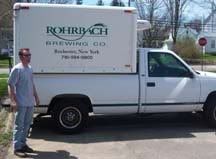
Bruce enjoying the Southern Tier sun
As far as beer festivals go, this one was pretty leisurely; not as crowded as TAP NY tends to get. One of the nice things about Ellicottvile is it's really small. We got to hang with everyone from the festival in the town's two bars, including the excellent bluegrass band Goodfellas, who kept us entertained as we despensed beer to the increasingly drunken masses.
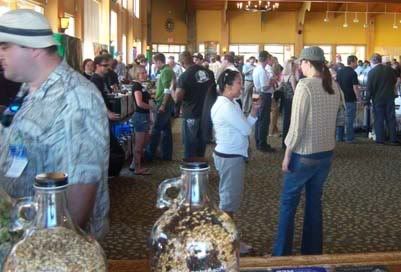
pouring Rohrbach beer for the huddled needy
Friday, May 04, 2007
The bell keeps ringing at beer school
Pat and myself are gratified by the, uh, demographic breakdown of our Beer School attendees. They skew heavily away from the traditional beer tasting audience. Keep showing up, ladies, and we'll keep a-pouring!
The next Beer School will be on Thursday, May 17. We'll be featuring the beers of Munich, Germany. Make no mistake; these are the finest beers in the entire world. If you don't believe me, you're wrong.
Come on out and I'll prove it.
-Mark
Wednesday, May 02, 2007
Slow posting
Anyway, Bruce and I will be in Ellicottville, NY this weekend for the Rites of Spring International beer & wine festival, sponsored by the Southern Tier Brewing Company and the Elicottville Brewing company. We'll be pouring for Rohrbach.
It's also time for another Beer School. Tomorrow night, 7pm, at Monty's Korner, Pat Hughes and I will acknowledge Cinco de Mayo by taking you through a flight of Mexican beers that have the distinction of not being Corona. We think it's the perfect way to prep for St. Patrick's Day Junior.
-Mark
Thursday, April 26, 2007
Thursday's Beer from the Other Side of the World

Harbin Lager from the great brewing nation of China.
Now I've had enough Asian beers to know what I'm getting into. I don't expect lagers that rival Munich Helles or Czech Pilsner. What I hope to find, however, is a crisp, refreshing, generally slightly malty lawnmower beer.
Harbin Lager is not crisp. It's not refreshing. If I had a lawn, this beer would get nowhere near it. A pale yellow color, thin vanishing head, and corny aroma scream "American Macro Lager." Unfortunately, the taste is even less memorable than any of those. If you're looking for an Asian option, grab a Tsingtao, Asahi, or Tiger Beer from Singapore over this any day of the week.
Monday, April 23, 2007
What's that bright yellow thing in the sky?

Bruce enjoying King Pilsner in the wrong glassware
I'm looking forward to TAP NY this weekend down Hunter Mountain way. I'll be pouring for Rohrbach, so let me know you read my shit and I'll give you an extra big sample glass. And then another.
-Mark
Friday, April 20, 2007
Awesome freakin' news!
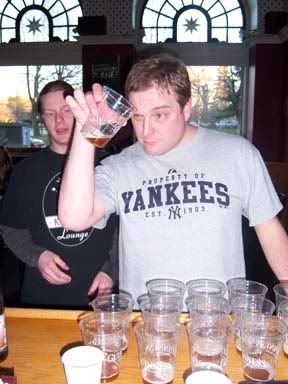
Pat Hughes and myself preparing a flight
Later on, I found out that Joe McBane, Cellar and Bar Manager for The Old Toad, is buying the old MacGregor's Gregory street locataion. "It's going to be the best beer bar in Rochester," he confidently stated.
I hope so. Downtown MacGregor's was my favorite bar, and I'd do anything to see that place opened again, especially by McBane, whose knowledge and passion for beer made the Toad's selection so eclectic and delightful. Good luck buddy!
Thursday, April 19, 2007
TAP NY looms large
This is a great festival. The food is awesome, the setting gorgeous, and you can try beer from over 30 New York State breweries. If you can make the trip to Hunter Mountain, it's worth considering.
-Mark
Tuesday, April 17, 2007
Beer School this week: Hefe-Weizen
We'll be prepping folks for the warmer weather by offering a flight of Hefe-Weizen, the preeminent Bavarian wheat beer. Come down and try examples from Munich and beyond, including the best that American craft brewers have to offer.
Hopefully, this time we can avoid the drunken financial analyst alpha male dudes and cackling office hens that the holiday stuck upon us at the last session.
-Mark
Wednesday, April 11, 2007
Beercraft newspaper column #37- Rohrbach at the Ballpark
By Mark Tichenor and Bruce Lish
Take me out to the baaall game
Take me out to the croooowd
Buy me some Scotch ale and IPA
I don’t want fizzy lager todaaaay…
Whoops! Sorry. It seems we’re getting a bit carried away now that baseball is back. Here’s to another season full of everything the old ball game is about: exciting defensive plays, towering home runs, and hurling verbal abuse at the visiting players.
And what’s baseball without beer? The two are inextricably linked. Across the country, ballparks have been good for the craft brewing industry. Most major league stadiums have at least one microbrewery stand. It’s a testament to how this section of the brewing industry has grown.
Our own stadium, Frontier Field, may not exactly be a major league park, but that doesn’t mean you’ll be hurting for decent beer. Let’s start behind home plate, at the Rohrbach Brewing Company stand. These guys have been making craft beer for the Rochester market for over a decade, and you can get some of their signature brews right there at the ballpark.
In fact, the Rohrbach Red Wing Red is only available at Frontier Field and the home brewpub. It’s moderately dark, sweet, toasty ale without a great deal of hop bitterness. This beer is pretty accessible, even to those who aren’t so used to micros, and it goes well with those Red Osier roast beef sandwiches.
For those who’d like a bit more kick, there’s the Rohrbach Scotch Ale, a Rochester classic. It’s much darker than the Red, but not as opaque as a porter or stout would be. As with all Scotch ales, malt rules the day, making for a very sweet, robust, slightly caramel flavor.
Be careful with the Scotch Ale, though. You might not necessarily taste it, but the 7.8% alcohol content can really catch up with you, especially in the heat of a summer day.
Rohrbach’s third offering is a lighter, more refreshing ale that just happens to taste like blueberries. One of the best things about BlueBeary Ale is that it follows the cardinal rule of fruit beers: Provide the essence of the fruit without clobbering the drinker with excess fruit flavor.
It’s actually done rather skillfully. When you lift the glass to your face, there’s a tantalizing whiff of fresh blueberry, but the flavor is all crisp, refreshing pale ale with just a hint of the berry’s presence.
It may not be the most macho beer in the ballpark, but if you were macho, you’d be at a tractor pull and not a baseball game, right? Plus, it’s much lighter in both body and alcohol content than the Scotch ale.
Ultimately, the enjoyment of beer is about context. The traditional beer of baseball is undoubtedly mass-market American Lager, and we’re happy to sit in the stands with a Genesee as well. Still, the beers from the Rohrbach stand are a pleasant alternative that will please more discerning palates, as well as a testament that good things can still come out of Rochester. If you’ve never tried craft beer, they’re also a great way to gently expand your taste range in a neutral setting. And they go nicely with Zweigle’s hot dogs.
Now if only we could get that Conehead guy to bring Rohrbach to our seats…
In Other Beers:
One of the primary ways for homebrewers to improve their skills is to talk to (and share beer with) other homebrewers. The Upstate New York Homebrewer’s Association (UNYHA) offers homebrewers of all skill levels an opportunity to share the highs and lows of their hobby, and they’re always welcoming new members.
The club hosts frequent events and meetings, and counts among its members some of the most skilled homebrewers in the region. Find them on that internet thing at www.unyha.com.
Beercraft is presenting Beer School: a free ongoing tasting session hosted by Mark Tichenor and Pat Hughes. This semi-educational event takes place every other Thursday, 7pm, at Monty’s Korner on the corner of Alexander and East Ave. On April 14, we’ll taste Hefe-Weizen. Come down and try some; we’ll even teach you how to pronounce it correctly. Ausgezeichnet!
Bruce is a certified beer judge and commercial brewer. Mark owns a laptop and likes beer. For more on beer, check out the beercraft blog, updated regularly, at http://beercraft.blogspot.com. Send your questions, suggestions, or comments to beercraft@rochester.rr.com
Tuesday, April 10, 2007
Genesee is there...somewhere
We will have 3 draft lines in the new 10th Inning bar that is currently under construction. Two of these will be Dundee’s lines and one will be a Genny Light line. We also have Genesee Beer and Genny Light available at the Bullpen concession stand.
So we'll look out and hope for the best.
-Mark
Monday, April 09, 2007
In the shadow of the brewery...
The stadium used to serve Genesee and Genesee Light: not craft beer by any stretch of the imagination, but the standard-bearers of a proud independent brewing tradition nonetheless. In fact, from the first-base seats, you can see the freakin' brewery a third of a mile away.

The Brewery's superstructure is in the distance, just to the left of the rightmost light tower
I don't know the detail of the beverage contract negotiations, but Rochester Community Baseball bringing in the Canadian Giant at the expense of a local icon is disturbing, to say the least. No Genesee. No Genny Light. No J.W. Dundee's.
Frontier Field is one of a handful of local attractions through which visitors are presented the unique and positive qualities of our city. I guess we can cross one off the list.
-Mark
Sunday, April 08, 2007
Weekend update
Friday, April 06, 2007
Opening Day!
Pics from Beer School shortly.
Wednesday, April 04, 2007
Beer School tomorrow at Monty's Korner
Anyway, tomorrow the subject is IPA. Come down, taste a range of both English and American interpretations of the style, get a pint of your choice, and scarf down a slice of the quintessential beer pairing food- pizza. It's free!
-Mark
Monday, April 02, 2007
Missed conversations
I need the comment filter to keep spam off the blog (there's tons of it), but I don't like it when your input gets lost. If you've left a comment that never showed up, check again. I think I've got them all.
Tuesday, March 27, 2007
Lewe's Arms Race
Needless to say, this has incensed the locals, who love their pub and their brewery. A boycott is in effect and business is off 90%.
I like Greene King's beers, but their attitude sucks. It's good to see a grassroots effort against corporate arrogance working for a change.
Monday, March 26, 2007
Beercraft newspaper column #36: Bock beer and Beyond
By Mark Tichenor and Bruce Lish
Is there anything that makes you feel as good as a newly-emerging spring? No longer does the frigid air sear your lungs with every breath. The trees are beginning to show some tentative yellow-green. Those nasty grey piles of icy sludge disappear from the roadside.
They feel good about the coming of spring in Germany, too. Now, it’s the traditional time to tap the bock beer.
In the days before refrigeration, brewers in the German Alps needed help from the winter to make their cold-fermenting strong lager. They would brew in December, storing the beer in frigid mountain caves. When spring came, with the hills once again dotted with the wild goats that have become the symbol of the style (“Bock” is “goat” in German), the stored beer would be ready.
And, like a wild goat, bock has a powerful kick. The traditional style is sweet, with little to no hop flavor, and all that malt masks the taste of the beer’s 6%+ alcohol content. Further up the scale, Doppelbocks (double bocks) can clock in at 9% alcohol by volume and the mighty Eisbock (ice bock), which has been frozen to remove water and concentrate the alcohol, can top 15%.
So let’s go up the ladder and try one of each. Spaten Bock is currently available around our fair city. It’s surprisingly light in color for a bock, but quite beefy in sweet malt flavor. You’ll detect a pleasant bready flavor imparted by the grains, yet it retains a crisp finish.
This beer is definitely robust enough to pair with a steak dinner, but probably goes best with sausages. We recommend pairing a pitcher of Spaten Bock with a couple of Bauernwurst at Swan Market, our favorite lunch hangout, on Parcells Ave.
Of course, there are times, such as after losing your job or when the in-laws visit, where the regular bock just isn’t enough. You can tell a Doppelbock by its name. Most of them end in “-ator,” is in Paulaner Salvator, Ayinger Celebrator, and Spaten Optimator.
In addition to its higher alcohol content, Doppelbock is also darker and sweeter. Hops, slightly perceptible in bock, are almost completely absent from the Doppelbock’s flavor profile. Instead, you’ll find complex raisin, grape, and toffee flavors.
Our favorite Doppelbock, Tucher Bajuvator, goes well with meat dishes and chocolate. If you’re having trouble sleeping, it could also be considered the ‘Ny-Quil’ of Germany.
If you’re one of those hoity-toity types whose idea of a perfect evening is sitting next to the fire in a smoking jacket sipping port, you might want to try Aventinus Eisbock for your next apertif.
The freezing and water removal of this beer is actually a form of distillation, so the line between beer and spirit begins to blur, as does everything else when you drink this stuff. In fact, it’s illegal to brew and sell Eisbock in New York State without a distiller’s license, so don’t expect Rohrbach, Custom Brewcrafters, or Southern Tier to dabble in this style anytime soon.
In fact, it’s hard to characterize the flavor of Eisbock as beer. It’s like a malt brandy, with a thick, chunky mouth feel. At this level of alcoholic content, the sweetness is intense, with cherry and plum notes. It’s really something to be sipped and appreciated instead of quaffed by the liter.
German bock beers are a strange dichotomy. They’re at once a hearty farmer’s festival beer and a sophisticated evening fare. They’re enjoyed on an equal footing by both metrosexual nightclubbers and big, red-faced dudes in Lederhosen.
In a society where beer is considered the basest of beverages, Styles like this prove to the wine and brandy crowd how complex, varied, and skillfully crafted a great beer can be. Prosit!
In other beers:
The biweekly 7pm Beercraft Tasting Session is continuing every other Thursday at Monty’s Korner. Last week Jason Fox, Head Brewer at Custom Brewcrafters, took a small but enthusiastic crowd through a range of bock beer.
These events are free, and there’s pizza too. Really, it’s a win-win situation. Come down, grab a sampler glass, and learn about the best beverages on the planet.
Bruce is a certified beer judge and former commercial brewer. Mark owns a laptop and likes beer. For more on beer, check out the beercraft blog, updated regularly, at http://beercraft.blogspot.com. Send your questions, suggestions, or comments to beercraft@rochester.rr.com.
Sunday, March 25, 2007
Bruce is returning to Rohrbach
Bruce was the brewer at Rohrbach's downtown Rochester location for a couple of years, until it closed. Now that the microbrewery is expanding again, he's back to brew their specialty ales.
It'll be a few months before you taste Bruce's beer, but trust me, it'll be worth the wait. It's a smart move on Rohrbach's part.
Thursday, March 22, 2007
Beer tasting tonight at Monty's Korner
An ale for what cures you?
I've not yet visited, but I have my doubts that a dude who built his nightlife empire on the dispensing of 2 for 1 Coors Light and Sexes on the Beach into giggly, barely legal proto-adults will put together a compelling beer menu. I could be wrong, though.
Anyway, next door, at Monty's Korner, there's a high quality, interesting lineup of beers. That's probably good enough for me.
Wednesday, March 14, 2007
Beercraft tasting on Thursday
The tasting is at 7pm tomorrow, at Monty's Korner in sunny Rochester, New York. It's free, with a free pint at the end. It's a pretty good deal, actually.
Tuesday, March 13, 2007
Beercraft newspaper column #35: St. Patrick's Day
By Mark Tichenor and Bruce Lish
Well, it’s that time of the year again; the time when everyone freaks out about all things Irish. Not that we’re complaining. After all, it’s much easier to wrap a beer column around a holiday like St. Patrick’s Day than, say, Arbor Day or President’s Week.
So you’re gonna dress up in green, pile the family into the SUV, and head on down to the scary, scary City for the parade. Chances are you’ll wind up with a Guinness in your hand, and that’s not a bad thing, even if you’re unfamiliar with the style.
Guinness is one of the most well-known beers in the world, and the preeminent Irish stout. Thanks to the brewery’s enormous marketing outlay, they have completely co-opted any religious significance that St. Pat’s still had, effectively turning March 17th into “Guinness Day. But we can forgive them for the ruthless commercialism, because they do brew a fine stout.
Irish stout as a beer style evolved from the dark, malty porters brewed in England during the 18th century. As Porter’s popularity waned in the big island, it remained popular in Ireland until the latter half of the 1800s. Arthur Guinness, local Dublin brewer, modified the beer until it suited local palates, using darker malt and changing the hop balance to create a full-bodied, nearly black brew which was less sweet than its ancestor, and that’s more or less what we have today.
Irish stouts like Guinness are carbonated with nitrogen, not carbon dioxide, so the bubbles are smaller. This gives the beer its distinctive cascading foamy pour, full body, and creamy head. The strong roasted malt dominates the flavor, but it’s skillfully balanced by the hop bitterness. You’ll also detect a slight sour astringency in the aftertaste.
Naturally, Guinness isn’t the only Irish stout. Ireland’s second city, Cork, is home to the two other big brewers of the style: Murphy’s and Beamish. These two lack some of Guinness’ bitterness and retain a bit more sweetness. However, they’re going to be a lot more difficult (nigh impossible at the moment, actually), to find on draft here. They’re only available in nitrogen cans at your favorite specialty beer store.
The dark color and thick mouth feel of Irish stout often leads people to assume that the style is very strong and highly caloric. Actually, the opposite is true. The only thing that makes stouts dark is the fact that the malt has been darkened by the roasting process. The “thick” feel is due to the nitrogen carbonation. A 20 ounce imperial pint of Guinness contains around 210 calories, fewer than in a pint of orange juice. And at 4.2% alcohol by volume, it’s no stronger than a typical American lager.
So Irish stout may not actually be diet food, but with its beautiful visual and flavorful aesthetics, it might be just the beer to inspire your poetic muse, just like it did for James Joyce, Brendan Behan, and that guy from the House of Pain. We’ll leave you to your pint with an old Irish proverb:
May the wind always be at your back
May Celtic win the Champion’s League
May your pint always be fresh
And may the road rise up to meet you (but not too hard)
In other beers:
If you like bowling, and you like good beer, check out L&M Lanes on Merchant’s road by Culver. Two floors of bowling lanes, a steel-tip dart board, and an impressive array of taps make for a fun, social evening. Standouts from the beer menu include Victory Prima Pils and one of our favorites, Southern Tier Phin and Matt’s Extraordinary Ale. These beers are just the thing for when you’re swinging hard15-pound spheres by the tips of your fingers.
Bruce is a certified beer judge and former commercial brewer. Mark owns a laptop and likes beer. For more on beer, check out the beercraft blog, updated regularly, at http://beercraft.blogspot.com. Send your questions, suggestions, or comments to beercraft@rochester.rr.com.
Monday, March 12, 2007
The perfict pint pour?
Anyway, Fergal Murray, Brewmaster at the Guinness Brewery, has advaice on how to pour the perfect pint.
Not that it matters. Except for the visual aesthetics, I've never felt it mattered if you waited 10 minutes or just slopped the stout into your glass. But I'm in the minority on this one.
I'm also in the minority of people that don't think Guinness tastes any different in Ireland. I've had Guinness all over Ireland, including the obligatory pint in the Brewery's Gravity Bar. It all tastes like the Guinness back home. Sorry, Tourism Ireland, but it's true.
Friday, March 09, 2007
Craft beer- it's insdious!
It shows that craft beer isn't viewed as a snobby drink for geeky engineers anymore. It's a legitimate segment of the beer industry, and it's selling to consumers outside its traditional base. If this continues, the USA will be a great brewing nation indeed.
Thursday, March 08, 2007
Relaxing on the Boulevard.
The Boulevard is a pleasant surprise. Owners Mike and Rob are really committed to good beer, and have dedicated plenty of tap space to craft brews. Thanks guys, for some great conversation and great beer.
-Mark
Monday, March 05, 2007
Beer Blogging...er...Monday?

Beer blogging Friday is a joint effort by beer writers Webwide to blog on a specific topic. Last Friday, the topic was stout. I missed the first round, but it got me thinking.
Thanks to the power of marketing money, stout in the USA is synonymous with Guinness. The Irish giant owns St. Patrick's Day, and is now trying to create its own holiday.
Guinness typifies Irish stout. Dry, slightly sour, with a moderate alcohol content served, of course with nitrogen combination. A freshly-dispensed Irish stout, with its cascading tumult of bubbles and puddinglike head, is possibly the prettiest sight in the world of beer.
But the real gem of the stout kingdom comes from the other side of the Irish sea. From London, actually; the home of milk stout.
First brewed in the 1870s as a nutritional beer, Milk stout is sweeter and thicker in body than its Irish cousin. The brew contains lactose, which doesn't ferment and adds the extra sweetness.
Around the turn of the 19th century, Milk stout was a signature London beer, much like porter was during the 1700s. Like many English beers, however, the changing of tastes away from real ale led to the near extinction of the style. The style is more or less recrated by several American microbrewers, but it's more of a dabbling than a serious attempt to revive the style.
The most prevalent tradional example is Mackeson's XXX Milk Stout. The Mackeson company and its US distributors have done an admirable job in making this beer available, so you can probably find it in your favorite specialty beer store. It's a treat on a cold winter night.
I'll be sure to join in for the next round of Beer Blogging Friday. It'll be fun to read other's takes, and it's always easier to post an entry when someone else is thinking up the ideas!
-Mark
Friday, March 02, 2007
Beer- the Rodney Dangerfield of booze
The trouble with referencing articles on the BBB is that J is so thorough in his writing. I can do little but add smartass comments. Stick to your specialty, I always say.
The original article is a typical "we need content- pronto" feature piece, done with conclusions already drawn, and backed up with zero research. I should know. I've written hundreds of pieces like that myself.
But that's fine when writing to an audience already predisposed to stick up their noses at beer. Wine snobs certainly aren't going to dig any more deeply. Hell, when you spend your adult life in restaurants which feature enormous wine lists and three shitty beer choices, you can be forgiven for developing a mindset in which beer is an inferior, unsubtle beverage.
The gastronomic community has done beer lovers a huge disservice, and Ms. Jordan's mindset as she writes her original article proves it. As Jordan writes:
While there are several different types of beer, most beer tastes relatively the same with some just not being quite as bad as others. Two different bottles of wine, however, can taste dramatically unalike. Wine drinkers are granted with the ability to pick from a variety of years, types, and flavors. They can choose red wine or white wine, wine from places as far as France or as close as Oregon. And, once engaged in a little wine tasting, wine drinkers can find a wine they really love.
That's not a malicious paragraph, it's an example of beer's marginalization in gastronomic circles.
Granted, craft beer has made huge strides, and the industry continues to grow at a healthy clip, but Ms. Jordan has show we have a long way to go.
Wednesday, February 28, 2007
Beercraft seminars, coming weekly to a pub near me!
The first one will be held Thursday, March 8, at 7pm. In keeping with the season, we'll be talking about Irish stout. We'll briefly discuss the history and aspects of the style,then taste a range of Irish stouts. Everyone in attendance gets a free pint of Stout, too.
It's a casual focus, so we're not getting into the hardcore date: degrees Lovibond, IBUs, that sort of thing. Still, all are welcome and we hope to see you there.
-Mark
Tuesday, February 27, 2007
Beercraft newspaper column #34- The anatomy of beer
By Mark Tichenor and Bruce Lish
I think we can all agree that beer in its modern form is the pinnacle of human achievement. But when it comes to educating the masses about beer, there’s still a long way to go. Not everyone’s a home brewer or beer connoisseur, so let’s take a look at what’s really in your pint glass.
Beer is simple yet complex, like Mexican food. There are only four main ingredients, but the variety of colors, flavors, and aroma is staggering. Today, we’ll talk about those ingredients and what they do.
First off, there’s the water. It might all be clear, but water varies in hardness, acidity, salinity, and proportion of mineral salts, and has a tremendous impact on the beer in which it goes. Great brewing towns like Munich or Burton-on-Trent have become brewing centers because the quality of the water in those areas was the best for brewing.
Interestingly, the water from Hemlock Lake is quite similar to the water in southern Germany, which is why many German brewers set up shop in the Flour City during the 19th century. With dissimilar H20, it would have been much more difficult to brew their beer to the style they were looking for.
Malted barley is the primary grain used in brewing. To make malt, the barley is germinated and then dried. This creates enzymes that convert the grain’s starch into fermentable sugar.
The germinated grain is dried in a kiln, and often roasted to various degrees. When you roast barley, it gets dark. That’s where dark beer comes from. Stouts like Guinness are made from barley that’s roasted until it’s almost black, whereas a light lager would use malt that’s just dried in the kiln.
Because of its sugar content, malt by itself would make for a very sweet beer. What’s needed is a flavor that balances that sweetness. That’s why we have hops.
Hops are a flower that stabilizes the beer and imparts bitter and floral characteristics. They also work as an antibiotic that kills microorganisms competing with the yeast. By themselves, hop flowers are oily and strong-smelling, and there are many types. The Saaz and Hallertau hops used in German beer differ noticeably in flavor and smell than the Fuggles and Goldings hops used in British ales. American IPAs often contain the piney Cascade hops from Washington State and Oregon.
For centuries, brewers combined these ingredients in various ways, adding a little beer from a previous batch, and then waited, and presto! New beer. It wasn’t until guys like Louis Pasteur came along in the middle of the 19th century that the function of the fourth essential ingredient, yeast, was understood.
Yeast is a microorganism that eats sugar and poops out alcohol. When introduced to the wort (as the freshly brewed pre-alcoholic beer is called), the yeast begins a wild orgy of gorging and reproduction, converting the sugars to alcohol until all that fuel is used up. Brewers can measure and control the sweetness and alcohol content by stopping the fermentation at the appropriate measurement.
As you’ve probably already guessed, there are multiple types of yeast, each with its own long, Latin name you probably don’t care about. Suffice it to say there are two categories: Top-fermenting and bottom-fermenting.
The top-fermenting yeast makes ale. It foams up on the surface of the wort, thriving at higher temperatures than its bottom-feeding cousin. Lager is made from the bottom-fermenting stuff. These yeasts need a longer, colder fermentation period, and impart a crisper taste.
Finally, there are adjuncts: Grains like rice and corn that are fermentable, but cost less than barley. American macro brewers use them to lower the cost of brewing so their shareholders can be happy. These grains also have their taste characteristics, as anyone who’s ever suffered through a warm Molson Golden can tell you, and give American light lager its signature flavor.
We don’t condemn the use of adjuncts, although our consumption of these beers is minimal. You drink what you like, and if you like Bud, than by all means, gulp away.
We, on the other hand, will be searching the internet for the definition of Reinheitsgebot.
Bruce is a certified beer judge and former commercial brewer. Mark owns a laptop and likes beer. For more on beer, check out the beercraft blog, updated regularly, at http://beercraft.blogspot.com. Send your questions, suggestions, or comments to beercraft@rochester.rr.com.
Monday, February 26, 2007
A surprise from Rohrbach
But I tried a sample. I then ordered a pint.
The stuff is good. There's a nice coffee essence that doesn't domintate the flavor of the beer, followed up by a pleasant porter flavor that could probably use a bit more body, but went down nicely nonetheless. Thanks to Rohrbach for nailing down a first-rate pint.
-Mark
Wednesday, February 21, 2007
What makes a good beer bar?
Now, to the topic at hand. What makes a good beer bar? Is it as simple as the presence of good beer? I don't think that's enough. For a bar to earn the esteemed title Beer Bar from the esteemed likes of Bruce and myself, certain criteria must be met.
There must be a broad selection of styles.
A bar that features beer from 15 different craft breweries is great, but when each beer is an IPA, it tends to fatigue my taste buds. Show me something across the range. Have at least one good lager, a hearty stout, and, dare I suggest, something on hand-pull.
The staff must know what the f*ck they're talking about
Everyone doesn't have to be a zymurgist, but a basic knowledge of beer styles, flavor characteristics, and, most importantly, pronunciation is nice. I once tried to order a Kapuziner Hefe-Weizen. After a few minutes of back and forth, the server came back with "Oh, you mean Ka-PEW-zinn-er!"
Bartenders and servers, you can pronounce "chipotle" without a hitch. Why can't you take two minutes at the start of your shift to nail the pronunciation of what your customers are going to be asking for? Communication is a wonderful thing.
The place has to be comfortable
There's nothing worse than a stuffy beer bar. I'm fortunate to live in Rochester, which has some nice, knowledgeable pubs that fit (and sometimes smell) like an old shoe. In bigger cities, the places with the best selection tend to be huge and corporate, with 100% monthly staff turnovers and slick margarita menus. I can never feel at home in one of those places.
That's all it takes to make me happy. I just wish places like that weren't so rare.
Tuesday, February 20, 2007
An unlikely scenario, part two: Bruce's list
Southern Tier Phin and Matts Extrordinary Ale
Zywiec Porter
Spaten Lager
Catamount 10th Anniversary IPA-(unfortunately no
longer produced)
Paulaner Hefe-Weizen
Bittburger Pils "Bitte ein Bitt"
Sheaf Stout
Tucher Bajuvator Doppelbock
AKTIEN - TÄNZELFEST
Sierra Nevada Celebration Ale
Yup, that's right, 5 of 10 are from Germany
-Bruce
Monday, February 19, 2007
An unlikely scenario
Eventually, the dreaded question was asked. "If you were stranded on a desert island with only 10 beers, which ones would you pick?"
Now assuage the more literal-minded readers, this is a purely hypothetical question that does not take into account temperature, storage, or an other external factor. We'll just assume everything is perfect, every time.
Mark's top 10:
- Tucher Bajuvator Doppelbock
- Spaten Muenchner Hell
- Warsteiner Dunkel
- Pilsner Urquel
- Saku Baltic Porter
- Southern Tier Phin and Matt's Extraordinary Ale
- Sam Smith Oatmeal Stout
- Delirium Tremens
- Great Divide Titan IPA
- Fuller's ESB
-Mark
Thursday, February 15, 2007
In Liverpool...
Hmm... I could do with a pint of Fuller's myself...
Wednesday, February 14, 2007
Blogger is driving me to drink
In the meantime, I'll talk more about beer. Bruce and I hit the new Webster MacGregor's for the second time. They just opened on Super Bowl Sunday, and appear to be firing on all cylinders. 85 taps and a very friendly server named Amanda will surely be the latest cause of my ruin.
-Mark
Tuesday, February 13, 2007
I may be lame, but I'm not extreme
"Your blog is getting really lame."
"I know I haven't been posting a lot. What sort of stuff would you like to see in the blog that would bame it better?"
"Anything but what you're posting."
Well shit, with constructive criticism like that, I can really gauge what's on the minds of the beer-oriented public. Personally, I don't want to write a lame blog; there are enough of those out there already. But that's why comments are enabled.
After writing about beer on a regular basis for over a year, it gets tough to think of new topics and takes. There is nothing I'd like more than input and subject suggestions from readers, but it's pretty rare. On the day ebaum's world linked to us, we had 3400 visitors. 3 left a comment.
So please, dear faithful, I want to know what you guys are interested in. I need your ideas. A vague put-down doesn't exactly help me make things more interesting.
Let's use that rant as the worst segue in the world, and get to today's topic, which is the extreme beer debate. Over the last few years, the trend in microbrewing, and microbrew distribution, has been toward ludicrously strong, comically bitter beers that strangle you with hop vines and leave you unable to drive home. These Imperial Pilseners, Imperial IPAs Quadruple bocks, and dubbel barley wines are simultaneously being heralded as the new revolution in American craft brewing and the scourge of the beer culture.
Personally, I don't view beer as vehicle with which to demonstrate my machismo. I also don't see it as a bullet-train delivering alcohol to my bloodstream as rapidly as possible. If I need a fast buzz that badly, vodka would be the superior choice.
Beer is social. When I'm out with my friends, it's far preferable to order several glasses of a weaker "session" beer that's perfectly brewed to style than a rosin-saturated alcohol bomb.
I guess I just like my nights to last longer than twenty minutes. Hey barkeep! Another Pilsener, and make sure there's nothing imperial about it.
-Mark
Monday, February 12, 2007
Beercraft newspaper column #33- Oh Canada!
Canadian beer
By Mark Tichenor and Bruce Lish
One nice thing about living in
Canadians, however, gets overshadowed by its gargantuan neighbor to the south, and it has become something of a point of pride to nurture and develop all things Canadian in a quest for national and cultural identity. Bookstores in
Whereas Americans have no problem making fun of our fizzy domestic lagers, Canadians tend to latch onto their brew with a fierce sense of civic pride. For the most part, Canadian mass-market lager is identical to ours, but it’s regarded as an expression of national culture by our friends north of the border.
And even though the Canadian beer industry has been gutted by takeovers, buyouts, and mergers, even though most Canadian beer has less character than Terrell Owens, even though there are some real duds (I’m talking to you, Alexander Keith’s “I.P.A.”), there are still some beers up there which really warrant a drive up to the duty-free shop.
Beers like Steam Whistle Pilsner. Brewed right at the base of
What Steam Whistle does have is the best pilsner in
The other great Canadian brewery is
No, seriously, it means “The End of the World,” and that’s precisely what you’ll wish for if you drink this Belgian style strong ale to excess. A sweet, citrus aroma, rich tawny gold color, and peppery sweet flavor make it a sensual beer. The warm, alcoholic finish offers plenty of warning about what you’re getting into.
Le Fin du Monde is a fantastic pairing beer, a perfect complement to meat, sausage, and strongly flavored fish dishes. It would also go nicely with fruit-based desserts. However, at 9% alcohol by volume it’s most frequently, however, it gets paired with Ibuprofen, inappropriate comments, and the barroom floor.
These are just a couple prominent examples of what’s going on in
Isn’t that what international cooperation is all aboot?
In other beers:
The Old Toad has just held a Beer and Dessert Pairing. Toad employee (and certified English girl) Katie Streets put together a five-course dessert flight, each cunningly paired with an appropriate, sometimes surprising beer. Among the highlights: Crème Brulee mated to Glenmorangie-infused Sam Smith Oatmeal Stout and Fresh Mint Chocolate chip Ice cream paired up with Brooklyn Chocolate Stout.
The desserts were made from scratch, the presentation excellent. It really highlighted the notion that beer is so much more than a buzz generator. Congrats to Katie and her fellow Toadies for going out on the limb,
Now if only they’d do a German beer and sausage pairing, but it’s doubtful that there’s much room for Old Jerry in this most English of pubs.
Bruce is a certified beer judge and former commercial brewer. Mark owns a laptop and likes beer. For more on beer, check out the beercraft blog, updated regularly, at http://beercraft.blogspot.com. Send your questions, suggestions, or comments to beercraft@rochester.rr.com.
Tuesday, January 30, 2007
Up or Downmarket? Michelob make up your mind
The brew, long dubbed as "a beer for connoisseurs," has been made with imported hops, a high percentage of two-row barley malt and adjuncts like rice and corn. Those adjuncts will be gone from the new recipes. A new embossed teardrop bottle is intended to give Michelob a "worth more" look as it tries to stay in the super premium niche among imports and specialty brews. A-B had adopted the microbrew practice of creating seasonal beers—such as Michelob Seasonal All Malt Lager in 2004-05—and sample cases. Yet the redo is not intended to align Michelob with craft beers, say wholesalers. Rather the strategy is to bring the brand closer to its original roots and target, which is older consumers. Product literature describes the target as 28 to 54-year-old drinkers who might be drawn to a beer with "more robust malty body and distinctive hop character.
First of all, it's awesome that this venerable American brew is returning to an all-malt formula, losing the corn and rice adjuncts. I think this will really give the brewers a chance to demonstrate high quality in what's traditionally perceived as a low-qual market. We'll definitely be trying this one when it launches.
But their brand concept, as reported in the story, is schizophrenic. It's great that the beer is being aligned as super-premium, with appropreate media support, packaging, and the other trappings of sophistication, but how the hell can you do that in 2007 without aligning the product with craft beers? Isn't it because of craft beers that these changes in production and marketing become necessary in the first place?
Michelob's brand managers will say they want to compete with import Eurolagers, not domestic micros. Fine, I'll give them that. But then they shouldn't count on "bringing the brand closer to its original roots and target." Michelob is an American beer, positioned higher up the chain than Busch, Stroh's, or Bud, but still available in $5 pitchers at the local watering hole. It's not a beer people drink to savor. They quench with it. They chug it. They bounce ping-pong balls into it, and that's just the way it is.
Michelob is making a mistake with a two-pronged branding strategy. Either consolidate the brand as super-premium, pushing the reversion to all-malt brewing, or go retro and appreal to the more ironically minded.
Shooting for both is likely to get them neither.
-Mark
Wednesday, January 24, 2007
Bad beer
While this site pulls no punches in calling out sub-premium American lagers, I'd like to see it expanded to include bad craft beer (of which there is an unfortunate abundance). So c'mon, Satan165 and Mark Blackout, grab your trusty thesaurus and let it rip.
Let me know if you need some suggestions. I try to be nice on my own blog.
Monday, January 22, 2007
It's the ritual, stupid!
I'll spare the gory details of the game's latter parts. You already know them.
The point is, I once again found myself hanging out at a buddy's house in front of the big-screen TV, watching the violent committee meeting that is NFL football, and it made me think about ritual.
It's a term we tend to associate with church, but the fact is that people like structure, and they use the trappings of ritual in all parts of their lives: How they get ready in the morning, how they operate at work, how they shop, and even how they play.
A sport is, after all, a ritual. It follows rules, uses iconography and uniform, and (usually) takes place at predefined times and places. Therefore it shouldn't be a surprise that fans find their own way to participate in the ceremony.
For me, and many others, beer factors prominently into the event. If I'm watching German Soccer, I'm drinking German lager, usually a beer from the city where the game is being played. English soccer might see me slurping down a Boddington's, and, for American Football and Baseball, I prefer macrobrewed American lagers; the very stuff most beer geeks rail against.
Are they the best beers? No. But Budwiser and its ilk are part of the ritual. You don't have a 1996 Ducru Beaucaillou as the wine in church communion. Likewise, high-end beer just seems inappropriate and it screws up the ritual.
Hmm, maybe if Gatorade marketed a sports beer, we'd have the best of all worlds. It sure would look good being foamily poured all over a Super Bowl-bound coach.
